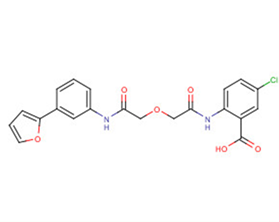
TM5441
CAS No. 1190221-43-2
TM5441( TM-5441 | BMS790052 | EBP883 )
Catalog No. M17864 CAS No. 1190221-43-2
TM5441 is an orally bioavailable inhibitor of plasminogen activator inhibitor 1 (PAI-1).
Purity : >98% (HPLC)
 COA
COA
 Datasheet
Datasheet
 HNMR
HNMR
 HPLC
HPLC
 MSDS
MSDS
 Handing Instructions
Handing Instructions
| Size | Price / USD | Stock | Quantity |
| 2MG | 43 | In Stock |


|
| 5MG | 71 | In Stock |


|
| 10MG | 110 | In Stock |


|
| 25MG | 237 | In Stock |


|
| 50MG | 444 | In Stock |


|
| 100MG | 631 | In Stock |


|
| 500MG | 1314 | In Stock |


|
| 1G | Get Quote | In Stock |


|
Biological Information
-
Product NameTM5441
-
NoteResearch use only, not for human use.
-
Brief DescriptionTM5441 is an orally bioavailable inhibitor of plasminogen activator inhibitor 1 (PAI-1).
-
DescriptionTM-5441, also known as EBP 883 and BMS-790052, is a potent plasminogen activator inhibitor-1 (PAI-1). TM-5441 inhibits several tumor cell lines with IC50 values between 9.7 and 60.3 μM. TM5441 protects against high-fat diet-induced obesity and adipocyte injury in mice.
-
In VitroTM5441 dose-dependently decreases HT1080, HCT116, Daoy, MDA-MB-231 and Jurkat cells with an IC50 ranging between 13.9 and 51.1 μM.TM5441 increases caspase 3/7 activity for both HT1080 and HCT116 cells in a dose dependant manner. TM5441 increases apoptosis in HT1080 and HCT116 cells.TM5441 induces mitochondrial depolarization.In mouse proximal tubular epithelial cells, TM5441 effectively inhibits PAI-1-induced mRNA expression of fibrosis and inflammation markers and also reverses PAI-1-induced inhibition of plasmin activity.
-
In VivoOral administration of TM5441 (20 mg/kg daily) to HT1080 and HCT116 xenotransplanted mice increases tumor cell apoptosis and has a significant disruptive effect on the tumor vasculature that is associated with a decrease in tumor growth and an increase in survival. The average peak plasma concentration is 11.4 μM one hour after oral administration and undetectable levels 23 hours after administration.TM5441 attenuates Nω-nitro-l-arginine methyl ester-induced cardiac hypertension and vascular senescence, prolongs lifespan in klotho null mice and elicits anti-tumorigenic and anti-angiogenic activities in cancer.
-
SynonymsTM-5441 | BMS790052 | EBP883
-
PathwayOthers
-
TargetOther Targets
-
RecptorPAI-1
-
Research Area——
-
Indication——
Chemical Information
-
CAS Number1190221-43-2
-
Formula Weight428.83
-
Molecular FormulaC21H17ClN2O6
-
Purity>98% (HPLC)
-
SolubilityDMSO : ≥ 300 mg/mL; 699.59 mM
-
SMILESO=C(O)c3cc(Cl)ccc3NC(=O)COCC(=O)Nc1cccc(c1)c2ccco2
-
Chemical Name5-chloro-2-(2-(2-((3-(furan-3-yl)phenyl)amino)-2-oxoethoxy)acetamido)benzoic acid
Shipping & Storage Information
-
Storage(-20℃)
-
ShippingWith Ice Pack
-
Stability≥ 2 years
Reference



-
Brr2 Inhibitor C9
Brr2 inhibitor C9 is an allosteric inhibitor of the spliceosomal RNA helicase Brr2. Brr2 is implicated in autosomal-dominant retinitis pigmentosa (a group of progressive retinal degenerative disorders).
-
Cucurbitacin I
Cucurbitacin I, a natural compound, is a selective inhibitor of JAK2/STAT3 with anti-cancer activity.
-
24-Norursodeoxycholi...
24-norursodeoxycholic acid is a side chain-shortened C23 homolog of UDCA.It has shown potent anti-inflammatory, anti-cholestatic, and anti-fibrotic properties.It is a Ursodeoxycholic Acid derivative. It is superior to Ursodeoxycholic acid in the treatment of sclerosing cholangitis in Mdr2 (Abcb4) knockout mice24-norUrsodeoxycholic acid markedly improved liver tests and liver histology and significantly reduced hydroxyproline content and the number of infiltrating neutrophils and proliferating hepatocytes and cholangiocytes.?



 Cart
Cart
 sales@molnova.com
sales@molnova.com


